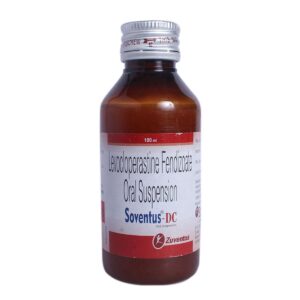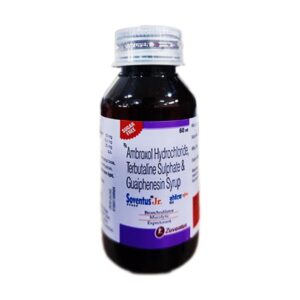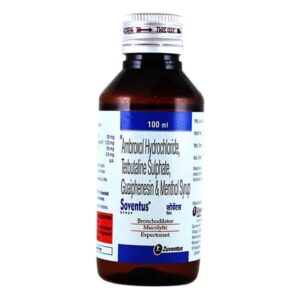AMBROXOL + SALBUTAMOL + THEOPHYLLINE
Ambroxol: Ambroxol is a drug that is primarily used to treat respiratory conditions such as coughs associated with excessive phlegm or mucus production. It belongs to a class of medications known as mucolytics.
The main mechanism of action of Ambroxol is to thin and loosen the mucus in the airways, making it easier to cough up. It achieves this by increasing the production and secretion of surfactant, a substance that helps to lubricate and protect the respiratory tract. This action helps to reduce the viscosity of the mucus and facilitate its clearance from the lungs.
Ambroxol is typically available in tablet, syrup, or solution forms and is taken orally. The dosage varies depending on the specific condition being treated and the age of the patient.
The usual adult dose of Ambroxol for coughs associated with excessive mucus production is 30 mg three times a day. For children, the dosage is adjusted based on their age and weight. It is important to follow the instructions provided by your healthcare provider or the instructions on the medication label.
While Ambroxol is generally well-tolerated, some common side effects may include nausea, vomiting, diarrhea, stomach discomfort, headache, and dizziness. These side effects are usually mild and temporary. If any severe or persistent side effects occur, it is important to seek medical attention.
It is worth noting that Ambroxol should not be used in patients with a known allergy or hypersensitivity to the drug. It is also contraindicated in patients with certain respiratory conditions such as asthma. Pregnant or breastfeeding women should consult their healthcare provider before using Ambroxol.
In summary, Ambroxol is a mucolytic drug that is used to treat respiratory conditions characterized by excessive mucus production. Its mechanism of action involves thinning and loosening the mucus, making it easier to cough up. The dosage and duration of treatment vary depending on the individual and the specific condition being treated. While generally well-tolerated, it is important to be aware of the potential side effects and consult a healthcare provider if any concerns or questions arise.
Salbutamol: Salbutamol, also known as albuterol, is a medication commonly used to treat and prevent the symptoms of asthma and other respiratory conditions like chronic obstructive pulmonary disease (COPD). It belongs to a class of drugs called short-acting beta-2 agonists, which work by relaxing the muscles in the airways, thereby making it easier to breathe.
Salbutamol is typically administered via inhalation using a metered-dose inhaler (MDI) or a nebulizer. The MDI delivers a measured dose of the medication, while the nebulizer converts the liquid medication into a fine mist that can be inhaled through a mask or mouthpiece.
The recommended dose of salbutamol depends on factors such as the patient’s age, severity of symptoms, and the specific device used for administration. Generally, for the treatment of asthma in adults and children over 4 years old, the usual dose is 1 or 2 inhalations (90-180 micrograms) every 4 to 6 hours as needed. However, it is essential to follow the prescribed instructions and consult a healthcare professional for personalized dosing recommendations.
Common side effects of salbutamol include tremors, headache, nervousness, dizziness, increased heart rate, palpitations, and muscle cramps. These side effects are usually mild and transient. In rare cases, salbutamol can also cause more severe side effects such as chest pain, irregular heartbeat, allergic reactions (rash, itching, swelling), and difficulty breathing. If any of these occur, immediate medical attention should be sought.
It is important to note that salbutamol is a rescue medication and should not be used as a substitute for long-term control of asthma. Patients with persistent asthma or frequent symptoms are often prescribed a different class of medications, such as inhaled corticosteroids, to manage the underlying inflammation and prevent exacerbations.
Theophylline: Theophylline is a medication that belongs to the class of drugs known as methylxanthines. It is primarily used in the treatment of respiratory conditions such as asthma and chronic obstructive pulmonary disease (COPD).
Theophylline works by relaxing and widening the airways in the lungs, allowing for easier breathing. It achieves this by inhibiting an enzyme called phosphodiesterase, which leads to increased levels of cyclic adenosine monophosphate (cAMP). Elevated cAMP levels result in smooth muscle relaxation and bronchodilation.
The dose of theophylline can vary based on factors like the individual’s age, weight, and specific medical condition. It is available in various forms such as tablets, capsules, and extended-release tablets. The medication is typically taken orally, and the dosage may be adjusted by a healthcare professional to achieve the desired therapeutic effect.
However, it is important to note that theophylline has a very narrow therapeutic index, meaning that the difference between a safe and toxic dose is minimal. Regular monitoring of blood levels is necessary to ensure that it remains within the therapeutic range and to prevent potential toxicity.
Like any medication, theophylline has potential side effects. Common side effects include nausea, vomiting, stomach pain, headache, tremors, and restlessness. It can also cause an increase in heart rate and may lead to palpitations or cardiac arrhythmias in some individuals. Severe or persistent side effects should be reported to a healthcare professional.
Additionally, theophylline can interact with other medications and substances, such as certain antibiotics, antifungals, and tobacco smoke, affecting its levels in the blood. It is crucial to inform the healthcare provider about all other medications being taken to avoid harmful drug interactions.
In summary, Theophylline is a medication used in the treatment of respiratory conditions like asthma and COPD. It works by relaxing the muscles of the airways, allowing for easier breathing. Proper dosage and regular monitoring of blood levels are essential to prevent toxicity. Side effects can occur, including gastrointestinal disturbances, nervous system effects, and cardiac arrhythmias. Consulting a healthcare professional for appropriate use and monitoring is crucial when using theophylline.



